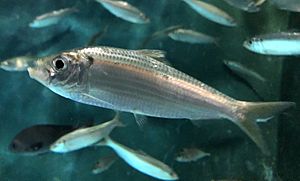Japanese sardinella facts for kids
Quick facts for kids Japanese sardinella |
|
|---|---|
 |
|
| Conservation status | |
| Scientific classification | |
| Synonyms | |
|
Harengula zunasi Bleeker, 1854 |
The Sardinella zunasi is a type of fish also known as the Japanese sardinella or Japanese scaled sardine. It belongs to the Clupeidae family, which includes herrings and other sardines. This fish lives in the northwestern Pacific Ocean. You can find it close to the coastlines of Asia, from southern Japan all the way to Taiwan.
Contents
About the Japanese Sardinella
This fish is usually about 10 centimeters (around 4 inches) long when it is fully grown. It generally has a slender body shape. However, its exact body shape can change a bit between different fish.
Where it Lives and its Life Cycle
The Japanese sardinella is a marine fish. It lives in large groups called schools in coastal waters. Sometimes, you can find these schools in bays. Some groups of these fish spend the winter in the Yellow Sea.
In the spring, these fish lay their eggs. They do this in the open ocean and in sheltered areas near the shore. The eggs hatch into tiny larvae in about 36 hours. These young fish can handle many different temperatures and levels of salinity (how salty the water is).
Importance and Conservation
The Japanese sardinella is a very important fish for fishing in Japan and China. People catch a lot of these fish for food. Because so many are caught, it is now considered an overexploited resource. This means too many are being fished, and their numbers are going down.
This fish is also often caught by accident. This happens when fishing boats are trying to catch other types of fish. This accidental catch is called bycatch.
Categories
See also
 In Spanish: Sardinella zunasi para niños
In Spanish: Sardinella zunasi para niños


